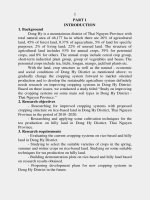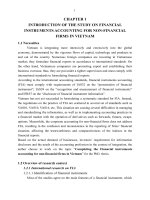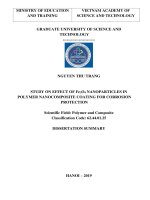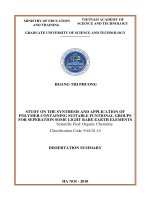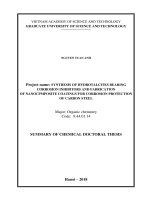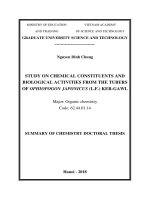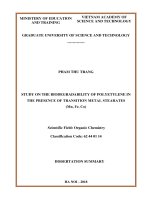Dissertation summary: Study on effect of Fe3O4 nanoparticles on polymer nanocomposite coating for corrosion protection
Bạn đang xem bản rút gọn của tài liệu. Xem và tải ngay bản đầy đủ của tài liệu tại đây (1.66 MB, 26 trang )
MINISTRY OF EDUCATION
AND TRAINING
VIETNAM ACADEMY OF
SCIENCE AND TECHNOLOGY
GRADUATE UNIVERSITY OF SCIENCE AND
TECHNOLOGY
------------------------
NGUYEN THU TRANG
STUDY ON EFFECT OF Fe3O4 NANOPARTICLES IN
POLYMER NANOCOMPOSITE COATING FOR CORROSION
PROTECTION
Scientific Field: Polymer and Composite
Classification Code: 62.44.01.25
DISSERTATION SUMMARY
HANOI – 2019
The dissertation was completed at: Institute for Tropical Technology Vietnam Academy of Science and Technology and Faculty of Chemistry,
Hanoi University of Science - Vietnam National University.
Scientific Supervisors:
1. Assoc. Prof. Dr. Trinh Anh Truc
Institute for Tropical Technology - Vietnam Academy of Science and
Technology
2. Assoc. Prof. Dr. Nguyen Xuan Hoan
Dept. Physical Chemistry, Faculty of Chemistry, Hanoi University of
Science - Vietnam National University
1st Reviewer: ...................................................................................
........................................................................................................
........................................................................................................
2nd Reviewer: ..................................................................................
........................................................................................................
........................................................................................................
3rd Reviewer: ..................................................................................
........................................................................................................
........................................................................................................
The dissertation will be defended at Graduate University of Science
And Technology, Vietnam Academy of Science and Technology, 18 Hoang
Quoc Viet, Cau Giay District, Hanoi City.
At… hour… date… month… 2019
The dissertation can be found in National Library of Vietnam and
library of Graduate University of Science And Technology, Vietnam
Academy of Science and Technology
ii
INTRODUCTION
1. Background
Metal and metal alloys are base materials that people have used for a
long time and play an important role in our new world without replacing.
With their own high chemical reactivity, metal and alloys easily
are corrosive in environment, especially in high temperature or electrolyte
solutions which is cause for having high socio-economic impacts, which
translate into substantial costs to the country. According to reports, around
1/3 of the mined metal all over the world cannot using anymore because of
corrosion. In addition to the direct damage that people can calculate,
corrosion of metals can also cause indirect damages such as reducing
machine durability and product quality, causing environmental pollution and
adverse effects to work safety. Therefore, the protection against metal
corrosion from the impact of the aggressive environment is becoming an
extremely pressing issue.
Protecting metal with organic coating has been widely used because of
its effectiveness, ease of processing and reasonable cost. Currently, the new
trend in the field of organic coatings is to find new inhibitors to replace toxic
chromates, creating an environmentally friendly coating, etc.
Nanotechnology has come to life and created tremendous breakthroughs.
Highly reactive pigments with nano dimensions when applied to organic
coatings to protect metal corrosion from concentrations of 2 - 3% show
breakthrough properties. In particular, iron oxides are considered as
pigments used in paint with all colors depending on the type of iron oxide
used, especially Fe3O4 magnetic iron oxide, corrosion protection ability so
far. The mechanism is still unclear.
For the above reasons, we propose the dissertation: “Study on effect
of Fe3O4 nanoparticles on polymer nanocomposite coating for corrosion
protection”
1
2. The main contents of the thesis
- Synthesis and characterization of Fe3O4 nanoparticles, -Fe2O3
nanoparticles and γ-Fe2O3 nanoparticles by hydrothermal method. Compare
the corrosion protection ability of epoxy film containing synthetic iron oxide
particles.
- Fabrication and evaluation of steel corrosion protection effect of
epoxy membrane containing magnetic iron oxide nanoparticles and nano iron
oxide from organic denaturation with some silane compounds and with
corrosion inhibiting compound.
- Research on using microstructure analysis methods to clarify the role
of nanoparticles in improving the anti-corrosion protection of products.
DISSERTATION CONTENTS
CHAPTER 1. LITERATURE REVIEW
The literature review provided an overview:
Introduction about iron oxides and their applications containing: FeO, αFe2O3, γ-Fe2O3, Fe3O4. This chapter focus on characteristic of structure,
properties and thermal synthesis method of Fe3O4.
Introduction about surface modification of Fe3O4 nanoparticles: surface
properties, modification method of particles, stabilization of particle
surface
Introduction about corrosion protection of coating prepared by polymer
nanocomposite.
CHAPTER 2. EXPERIMENTS
2.1. Material and equipments
FeSO 4 .7H 2 O , FeCl 3 .6H 2 O, KOH, C 2 H 5 OH, Xylene, HCl, HNO 3 ,
N-(2-Aminoethyl)-3-aminopropyltrimethoxysilane
(APTS),
Diethoxy(methyl)phenylsilane (DMPS), Tetraethoxysilane ( TEOS),
Indol 3-Butyric axit (IBA), Irgacor 252, 2-(1,3-Benzothiazol-2-ylthio)
succinic axit (BTSA), epoxy resin (Diglycidyl ete of Bisphenol A,
Epotec YD 011-X75) and hardener polyamide 307D-60.
2.2. Synthesis iron oxides by hydrothermal method
Synthesis α-Fe2O3 nanoparticles : FeCl3.6H2O was dissolved with
distilled water. Under stirring, a KOH solution was added to the
solution until the formation of a precipitate occurred. Hydrothermal
2
reaction was conducted at 180oC for 15 h. After reaction, the precipitate
was washed with distilled water and dried in a vacuum oven.
Synthesis Fe3O4 nanoparticles: a mixture of FeCl3.6H2O/FeSO4.7H2O
(molar ratio Fe2+/Fe3+ = 1/1) was dissolved with distilled water. Under
stirring, a KOH solution was added to the solution until the formation
of a precipitate occurred. Hydrothermal reaction was conducted at
150oC for 7 h. After reaction, the precipitate was washed with distilled
water to remove impurity ions (Cl- , SO42- , K+ ) and dried in a vacuum
oven.
Synthesis γ-Fe2O3 nanoparticles: Thermal treatment process for
synthesized Fe3O4 nanoparticles at190oC for 2 hours
2.3. Modification Fe3O4 nanoparticles with organic compounds
Modification Fe3O4 nanoparticles with silane: Silane was dissolved
with mixture solvent of etanol/distilled water (19/1 ratio). Fe3O4 was
added to the solution then stirring and using ultrasonic vibration. The
reaction mixture was kept at 60oC for 60 minutes with mechanical
stirring. Afterwards, particles were washed and dried in oven at 50 oC
for 10 hours.
Modification Fe3O4 nanoparticles with corrosion inhibitors: IBA (or
BTSA) was dissolved in a water/ethanol mixture (1/19 ratio). Then, the
Fe3O4 nanoparticles were dispersed by disperser and then mechanically
stirred and ultrasonic vibrated for 15 minutes and 30 minutes,
respectively. The mixture was left in 3 hours. Afterwards, the
precipitate was filtered and washed with ethanol several times to
remove the excess IBA. The modified Fe3O4 nanoparticles were finally
dried in a vacuum oven at 60oC for 10 hours.
2.4. Preparation of epoxy coating containing iron oxides and modified
iron oxides
Carbon steel plates (150 mm x 100 mm x 2 mm) were used as substrates
which were cleaned and dried before coating. The pre-polymer mixtures
(with or without particles) were applied by spin-coating at a speed of 600
rpm for 1 min. After polymerization and drying at room temperature for 24
hours, the coatings were about 30 µm.
3
2.5. Analytical characterizations for nanoparticles
FT-IR analysis, X-rays diffraction, UV-Vis, TGA analysis, SEM, Zeta
potential, saturation magnetization.
2.6. Method for evaluation properties of coatings:
Evaluation method for physical and mechanical properties of coatings:
impact strength, pull-off strength, wet adherence.
Corrosion testing for coatings:
+ Electrochemical impedance spectroscopy
+ Salt spray test was used in order to evaluate the corrosion
protection of the samples.
CHAPTER 3. RESULTS AND DISSCUSIONS
3.1. CHARACTERISTICS AND PROPERTIES OF IRON OXIDES
3.1.1. Characterization of Fe3O4 nanoparticles
Figure 3.1. The XRD pattern of pure
magnetite obtained by hydrothermal method
Figure 3.1 showed the diffraction pattern
that allowed for unequivocal identification of
magnetite; using the ICSD (Inorganic Crystal
Structure Database) reference code 01-076-1849 for magnetite the
diffraction peaks were identified.
Figure 3.2. SEM micrographs of Fe3O4 obtained by hydrothermal method
Figure 3.2. showed SEM images of Fe3O4 particles obtained by the
hydrothermal treatment. The uniform particle morphology and size of
synthesized Fe3O4 were observed. The results confirm that nanoparticles
with average particle size around 50 - 70 nm were observed.
4
%T
FTIR spectrum of Fe3O4 nanoparticles is shown in Figure 3.3.
Figure 3.3. FT-IR spectrum of
Fe3O4 nanoparticles
The result showed that absorptions in
3431 cm–1 and 1629 cm–1 are responsible to
O-H that adsorbed on the surface of the
nanoparticles and absorption at 586 cm–1 and
447 cm–1 are related to Fe-O bonds in
Số sóng (cm )
nanoparticles.
3.1.2. Characterization of α-Fe2O3 nanoparticles
-1
Figure 3.4. The XRD pattern of pure
magnetite obtained by hydrothermal
method
Figure 3.4. showed the diffraction pattern that allowed for unequivocal
identification of hematite; using the ICSD (Inorganic Crystal Structure
Database) reference code 01-079-0007 for hematite the diffraction peaks
were identified.
Figure 3.5. SEM micrographs of α-Fe2O3 particles obtained by
hydrothermal method
Figure 3.5. showed SEM images of α-Fe2O3 particles obtained by the
hydrothermal method. The uniform particles in morphology and size of
synthesized Fe3O4 were observed. The results confirm that nanoparticles had
average particle size around 70 - 80 nm which was not good in comparison
with Fe3O4
5
1625
3420
565
476
%T
FTIR
spectrum
of
α-Fe2O3
nanoparticles is shown in Figure 3.6. The
result showed that absorption at 565 cm–1 and
476 cm–1 are related to Fe-O bonds in
nanoparticles and absorptions in 3420 cm–1
and 1625 cm–1 are responsible to O-H that
absorbed on the surface of the nanoparticles.
4000
3000
2000
1000
Số sóng (cm-1)
Figure 3.6. FT-IR spectrum of
α-Fe2O3 nanoparticles
3.1.3. Characterization of γ-Fe2O3 nanoparticles
Figure 3.7. The XRD pattern of a)
Fe3O4 và b) γ-Fe2O3
In comparison with XRD pattern of Fe3O4,
the peaks were shifted slightly that allowed for
unequivocal identification of maghemite; using
the ICSD card no. 01-083-0112. No additional
diffraction peaks of any impurity were detected,
demonstrating the high purity of the synthesized samples.
Figure 3.8. Hysteresis loop of Fe3O4 and
(a)
γ- Fe2O3 particles. Image of magnetite and
(b)
maghemite nanoparticles were manipulated by
magnet (small image)
These results showed clearly that the Fe3O4 and
H (Oe)
γ- Fe2O3 nanoparticles exhibited superparamagnetic
behavior which obtained the highest magnetization saturation value (Ms) of 81
emu/g and 60 emu/g, respectively.
100
80
M (emu/g)
60
40
20
0
-20
-40
Fe3O4 (a)
γ-Fe2O3(b)
-60
-80
-100
-15000 -10000
-5000
0
5000
10000
15000
Figure 3.9. SEM micrographs of γ-Fe2O3 nanoparticles
The results SEM confirm that γ-Fe2O3 nanoparticles are similar in size with
Fe3O4 nanoparticles.
6
623
3436
3000
3000
2000
2000
-1)-1)
SốSốsóng
(cm
sóng (cm
1000
1000
577
%T
T (%)
1632
1122
2938
100
Figure 3.10. FT-IR spectrum
of γ -Fe2O3 nanoparticles
The result showed that absorptions
in 3420 cm–1 and 1625 cm–1 are
responsible to O-H that adsorbed on the
surface of the nanoparticles and
absorption at 565 cm–1 and 476 cm–1 are
related to Fe-O bonds in nanoparticles.
3.1.4. Effect of nanoparticles on corrosion protection of epoxy coating
Corrosion protection of epoxy coating containing 3% wt. particles was
demonstrated by electrochemical impedance spectroscopy (EIS).
After 1 hour immersion in 3 % NaCl solution, electrolyte had not
penetrated in the coating yet. After 14 days immersion, the EIS diagram of
pure epoxy coating presented two circles well defined. In the other hand, EIS
diagram of epoxy/ γ-Fe2O3 showed that a third time constant appeared in the
medium frequency range because of the reaction between particles and epoxy
coating. The particles filled the holes in the surface of coating and prevented
the electrochemical process taking place.
Figure 3.11. Nyquist plots
for the epoxy coating
Figure 3.12. Nyquist plots
for the epoxy coating containing
3 % wt. α-Fe2O3 nanoparticles
Epoxy/α-Fe2O3
7
After 42 days of immersion, for the epoxy coating containing α-Fe2O3,
the second cycle at low frequencies was determined. The result showed
that α-Fe2O3 play the role of a pigment which increase the barrier property of
coating. The EIS diagram of epoxy coating containing γ-Fe2O3 are did not change
the shape.
After 84 days immersion, impedance value of epoxy coating containing
Fe3O4 was higher than this value of another coatings because of interacting
of particles and oxides appearing at the steel/coating interface.
Figure 3.13. Nyquist plots for
the epoxy coating containing 3 % wt.
γ-Fe2O3
Figure 3.14. Nyquist plots for
the epoxy coating containing 3 %
wt. Fe3O4
|Z|1Hz
10
Figure 3.15. Variation of Z1Hz
values with immersion time in NaCl
3% solution of pure epoxy coating,
epoxy coating containing 3% wt.
iron oxides: epoxy/Fe3O4, epoxy/ αFe2O3 và epoxy/γ-Fe2O3
10
10
9
10
8
10
7
10
6
10
5
Epoxy
Epoxy/Fe3O4
Epoxy/γ-Fe2O3
Epoxy/α-Fe2O3
0
20
40
60
80
100
Thời gian (ngày)
After 84 days of immersion, among coatings, the epoxy/Fe3O4 coating
had highest impedance modulus.
These result shown that the presence of iron oxides in epoxy matrix
significantly improved the barrier properties of the coating, especially Fe3O4.
8
3.1.5. Mechanical properties of epoxy coating containing iron oxides
Table 3.1. Pull-off strengths and impact strengths for epoxy coating
and epoxy coating containing 3% wt. iron oxides
Samples
Pull-off strength (MPa)
Impact strength
(kg/cm)
Pure epoxy
3,5
180
Epoxy/Fe3O4
6,0
>200
Epoxy/α-Fe2O3
7,0
Epoxy/γ-Fe2O3
6,2
Diện tích bong rộp %
120
MT
NF
AF
G-AF
80
(a)
40
(b)
(d)
(c)
0
31
26
3
10
4
24
Thời gian (giờ)
Figure 3.16. Delaminated area
showing the adhesive loss vs immersion
time in water: pure epoxy coating (a),
epoxy coating containing 3% wt. Fe3O4 (b),
α-Fe2O3 (c) and γ-Fe2O3 (d)
The increasing of wet adhesion of epoxy coating containing iron oxides
can be explained by the cooperative bonds between the iron oxides (Fe3O4,
α- Fe2O3 or γ-Fe2O3) and the oxide layer at the steel/coating interface which
prevent water penetrated through the coating.
3.1.6. Morphology of epoxy coating containing 3% wt. Fe3O4
nanoparticles
Figure 3.17. SEM images of a fracture surface of epoxy coating
containing 3 % wt. Fe3O4
SEM imagines show the agglomeration of Fe3O4 particles in epoxy coating.
Therefore modifying surface of particles by organic compounds was necessary
which improved the dispersion of Fe3O4 particles in epoxy matrix. The particular
properties of particles will not be changed in modifying process.
9
3.2. CHARACTERIZATION OF CORROSION PROTECTION OF
EPOXY CONTAINING Fe3O4 AND MODIFIED Fe3O4
3.2.1. Characterization of corrosion protection of epoxy coating
containing silane modified Fe3O4 nanoparticles
3.2.1.1. Characterization of Fe3O4 nanoparticles modified by silanes
FT-IR analysis
Figure 3.18. FT-IR spectrum of Fe3O4
and Fe3O4 modified by silanes: ATPS,
DMPS, and TEOS
The spectrum of silane modified Fe3O4 nanoparticles presents the
bands at 1120 cm-1 and 1050 cm-1 characteristic of Si-O-Fe and Si-O-Si
groups, respectively. This result indicates that silanes have been successfully
grafted onto the surface of Fe3O4 nanoparticles.
DTA/TG analysis
The results showed on DTA curves improved that Fe3O4 nanoparticles
were modified by silanes (APTS, DMPS, TEOS).
Surface potentials of Fe3O4 nanoparticles and silanes modified
Fe3O4 nanoparticles
Figure 3.19. Surface potentials distribution of Fe3O4 and Fe3O4
modified by silanes: APTS, DMPS và TEOS
The surface potential of Fe3O4 and modified Fe3O4 nanoparticles were
measured in a zeta potential analyzer (Figure 3.19). In the surface potentials
distribution plot of Fe3O4, there were 2 peaks focus on the value at -40 mV
and indicates the average value -21.8 mV. As a result of -OH groups in the
surface of Fe3O4 nanoparticles due to the following model: (surface)(OH–)n . The average surface potential of modified Fe3O4 with APTS,
DMPS and TEOS are -19.31 mV; -19.05 mV and -18.15 mV, respectively.
10
Therefore, -OH groups on the surface of Fe3O4 nanoparticles had a reaction
with –OH of silane molecules which lead to change in the surface potential
of nanoparticles. The observed zeta potential value shows the less stability
of the Fe3O4 nanoparticles.
Magnetic property of silane modified Fe3O4 nanoparticles
Figure 3.20. Hysteresis loops of
modified Fe3O4 particles
100
80
M (emu/g)
60
Fe3O4/APTS
Fe3O4/DMPS
Fe3O4/TEOS
40
20
0
-20
75
The hysteresis loops of the modified
magnetic particles obtained using a
magnetometer are show in Figure 3.20. The
H(Oe)
values of saturation magnetization the Fe3O4
nanoparticles modified by APTS, DMPS and TEOS are 79.8 emu/g, 81.8
emu/g and 81.9 emu/g, respectively.
3.2.1.2. Characterization of corrosion protection of epoxy coating
containing silane modified magnetite nanoparticles.
EIS measurements were carried out to evaluate the corrosion resistance
of the carbon steel covered by epoxy coating containing 3% wt. silane
modified magnetite nanoparticles.
-40
70
-60
-80
-100
-15000 -10000
65
-5000
0
2500
5000
3500
10000
4500
15000
Figure 3.21. Nyquist plots
for the epoxy coating containing
3 % wt. Fe3O4/APTS
Fe3O4/APTS
After 1 hour immersion in 3 % NaCl solution, the EIS diagram of three
kinds of coatings presented one circle with very high value. After 24 days
immersion, for epoxy coating containing Fe3O4/TEOS the second cycle at
low frequencies were not determined. When immersion time reach to 42
days, the EIS diagram of all coatings presented two circles well defined. This
indicates that electrolyte penetrated in the coating and the corrosion process
occurred at metal surface. However, the impedance values of epoxy coating
11
containing silane modified Fe3O4 nanoparticles were high after along
immersion time. This result showed that surface modification by silanes
enhanced protection efficiency of Fe3O4 on epoxy coating.
Figure 3.22. Nyquist
plots for the epoxy coating
containing 3 % wt.
Fe3O4/DMPS
Figure 3.23. Nyquist
plots for the epoxy coating
containing 3 % wt.
Fe3O4/TEOS
Fe3O4/DMPS
Fe3O4/TEOS
The variation of Z1Hz values with immersion time in NaCl 3% solution
are presented in Figure 3.24.
The Z1Hz value of epoxy/Fe3O4/DMPS were equivalent with the one of
epoxy/Fe3O4 while epoxy/Fe3O4/APTS and epoxy/Fe3O4/TEOS have highest
impedance modulus. The best values and best protection were obtained with
the epoxy coating containing Fe3O4/APTS and Fe3O4/TEOS.
9
10
Figure 3.24. Variation of Z1Hz values
with immersion time in NaCl 3% solution of
epoxy coating containing 3% wt. Fe3O4 and
silanes modified Fe3O4
8
|Z|1 Hz
10
7
10
Fe3O4
Fe3O4/APTS
Fe3O4/DMPS
Fe3O4/TEOS
6
10
5
10
0
20
40
60
80
100
Thời gian (ngày)
The SEM micrographs (figure 3.25 to 3.27) showed that surface
modification Fe3O4 by silanes decreased the cluster in the epoxy matrix
significantly. The images indicated that Fe3O4/APTS had highest dispersion
in the polymer matrix.
12
Epoxy/Fe3O4/APTS
Figure 3.25. SEM images of a fracture surface of epoxy coating
containing 3% wt. Fe3O4/APTS
Epoxy/Fe3O4/DMPS
Figure 3.26. SEM images of a fracture surface of epoxy coating
containing 3% wt. Fe3O4/DMPS
Epoxy/Fe3O4/TEOS
Figure 3.27. SEM images of a fracture surface of epoxy coating
containing 3% wt. Fe3O4/TEOS
Physical mechanical properties of epoxy coating containing silane
modified Fe3O4
The increasing of wet adherence of epoxy coating containing iron oxide have
the reason that the interaction between iron oxides (Fe3O4, α- Fe2O3 or γFe2O3) and iron oxides occur at the surface of carbon steel prevent water
penetrated through the coating.
The pull-off strength of epoxy coating containing Fe3O4/APTS and
Fe3O4/TEOS increased significantly in comparison with epoxy coating containing
Fe3O4. In wet condition, it observed that adhesive loss of the coating with
Fe3O4/APTS was smallest after 24 hours immersion in water. While this loss of
coating with Fe3O4/TEOS was equal to coating with Fe3O4/DMPS.
13
Table 3.2. Pull-off strengths and impact strengths for epoxy coating
containing Fe3O4 and Fe3O4 modified by silanes
Pull-off strengths impact strengths
Samples
(MPa)
(kg/cm)
Epoxy - Fe3O4
5,9
>200
Epoxy - Fe3O4/ATS
7,1
Epoxy - Fe3O4/DMPS
6,0
Epoxy - Fe3O4/TEOS
7,8
Figure 3.28. Delaminated area
showing the adhesive loss vs immersion
time in water: epoxy coating with Fe3O4
(a), Fe3O4/APTS(b), Fe3O4/DMPS (c),
and Fe3O4/TEOS (d)
Diện tích bong rộp %
100
80
60
(a)
40
(b)(c) (d)
20
0
31
2
3
4
24
10
Thời gian (giờ)
6
NF
NF-ATS
NF-DMPS
NF-TEOS
3000
2000
SốBước
sóng sóng
(cm-1(cm
) -1)
2000
447
585
755
1197
1160
588
1110
450
1099
1630
3000
1422
1455
2852
2924
1710
1000
1385
1630
2920
2849
3433
503
3440
(%)(%)
Độ truyềnTqua
593
435
BTSA
740
1694
4000
4000
Fe3O4/BTSA
3435
Fe3O4
447
585
1099
1057
1630
2947
1621
1455
1427
2602
3036
IBA
1386
1629
3435
2921
Fe3O4/IBA
3393
(%)(%)
T qua
Độ truyền
Fe3O4
3433
3.2.2. Corrosion protection performance of epoxy coating with Fe3O4
nanoparticles modified by organic inhibitors
3.2.2.1. Characterization of Fe3O4 nanoparticles modified by organic
inhibitors
FT-IR and DTA/TG analysis
1000
SốBước
sóng sóng
(cm-1(cm
) -1)
(a) : Fe3O4 modified by IBA and pure IBA (b): Fe3O4modified by BTSA and pure BTSA
Figure 3.29. FT-IR spectrum of Fe3O4 and Fe3O4 modified by IBA and
pure IBA (a), Fe3O4 modified by BTSA and pure BTSA (b)
The spectrums of all samples presents the bands characteristic for –OH
group and Fe-O groups. The –CH2 characteristic peaks were observed at
2921 cm-1 (Fe3O4/IBA) and 2920 cm-1 (Fe3O4/BTSA) while C=C of –C6H5
14
groups were observed at band 1385 cm-1-1630 cm-1. These peaks were also
found in the spectrum of pure IBA and BTSA. The comparison of these
spectras showed the presence of the IBA and BTSA molecules on the surface
of the Fe3O4 nanoparticles.
The DTA curves of Fe3O4/IBA và Fe3O4/BTSA samples showed a
broad exo-thermic peaks at range 200 - 450oC which is due to thermal
decomposition of two organic components IBA and BTSA. The results
confirmed the presence of inhibitors on the surface of Fe3O4 nanoparticles.
Surface potentials of Fe3O4 and modified Fe3O4by IBA and BTSA nanoparticles
Figure 3.30. Surface charge
distribution on Fe3O4 nanoparticles
modified by IBA and BTSA
Figure 3.30 shows the surface charge distribution for Fe3O4
nanoparticles modified by IBA and BTSA. For the Fe3O4/IBA and
Fe3O4/BTSA nanoparticles, the average surface charge was shifted to a more
negative region in comparision with Fe3O4 nanoparticles. Average Zeta
potential of Fe3O4/IBA and Fe3O4/BTSA nanoparticles were -27,29mV and
-29.61 mV, respectively. The results showed the uniform on surface potential
of Fe3O4 modified by inhibitor, especially by IBA.
OOC
HOOC
OH
HO
OH
HO
N
H
N
Fe33O
O44
Fe
HO
H
OH
H
Fe3O4
O
H
N
H
HO
HO
O
OH
COO
OH
n
Indole-3-butyric acid (IBA)
CO O
CO O
N
N H
O
O
O OC
H
H
N
Fe3O4
O
O
N
H
O
H
O
N
CO O
H N
O OC
O OC
Figure 3.31. Absorption model of IBA molecules on the surface of Fe3O4
nanoparticles
15
Nồng độ chất hấp phụ (mg/g)
To explain these results, we assume that IBA molecules carried
positive charge on N atoms and surface of Fe3O4 particles had negative
charge (The negative charge on the particles surface can be attributed to the
adsorption of -OH group from the alkaline medium during the hydrothermal
reaction). IBA molecules adsorption on Fe3O4 particles surface through –OH
groups and created N…O which connected IBA and Fe3O4 nanoparticles. In
the outside, COO- groups carried negative charge which shifted surface
potential of particles to a more negative region.
The increasing negative charge of modified samples in comparison
with pure sample showed show that surface of Fe3O4 particles were changed.
Along with FTIR and TGA results confirm that IBA and BTSA molecules
presence on the surface of Fe3O4.
The absorption and release of organic inhibitors on the surface of
Fe3O4 nanoparticles
* The adsorption of organic inhibitors on the surface of Fe3O4
nanoparticles
60
BTSA
50
40
Figure 3.32. The absorption
diagram of organic inhibitors on the
surface of Fe3O4 nanoparticles
IBA
30
20
10
0
0
50
100
150
200
Thời gian (phút)
The result showed that the time
to Cmax of two samples was 30
minutes and Cmax was over 50 mg/g.
* The release of inhibitors in distilled water with three pH value ,
from the modified Fe3O4 particles.
To show the IBA effect on the corrosion protection, the release of IBA
in distilled water, from the IBA– Fe3O4 particles was measured by UV–Vis
spectroscopy for three pH value
16
Hàm lượng chất ức chế giải thoát (%)
50
IBA
BTSA
Figure 3.33. Release amount of IBA
and BTSA from the modified Fe3O4
particles vs pH in distilled water
40
30
20
10
0
It is observed that the corrosion
pH
inhibitor release increases for the high pH
value. It can be recalled that the corrosion process induces an increase of the
local pH due to the cathodic reaction of oxygen reduction. Thus, the release
of IBA and BTSA, favored in alkaline conditions, will lead to the corrosion
inhibition of the carbon steel.
Magnetic property of Fe3O4 modified by organic inhibitors
nanoparticles
2
4
6
8
10
12
100
80
M (emu/g)
60
Figure 3.34. Hysteresis loops of Fe3O4
modified by organic inhibitors nanoparticles
Fe3O4/IBA
Fe3O4/BTSA
40
20
0
-20
-40
-60
-80
-100
-15000 -10000
-5000
0
5000
10000
15000
H(Oe)
It observed that magnetic property of
Fe3O4 nanoparticles was unchanged when
absorpted the organic inhibitors on the surface.
3.2.2.2. Polarization curves
Figure 3.35. Polarization curves
obtained for the carbon steel electrode
after 24 h of immersion in the 0.1 M
NaCl solution: (○) 3% wt. Fe3O4,
(●)3% wt. Fe3O4/IBA, (▼)10-3M IBA,
(—)blank solution
17
The polarization curves obtained for the carbon steel in the 0.1 M NaCl
solutions containing Fe3O4 or IBA–Fe3O4 nanoparticles are presented in
Figure 3.35.
In solution with 10-3M IBA, it can be seen that the corrosion potential
is shifted in the anodic direction (about 100 mV) and the anodic current
densities are significantly lower by comparison with the blank solution,
particularly near the corrosion potential. This result confirmed the inhibitive
properties of IBA and showed that the compound is an anodic inhibitor. The
polarization curves obtained in the presence of Fe3O4 or IBA–Fe3O4
presented similar shape.
The corrosion potential is shifted toward cathodic potentials by
comparison with the blank solution and the current densities are significantly
lower. For both types of magnetite, accumulation of particles on the carbon
steel surface was observed after the electrochemical measurements. This
observation can explain the results observed in the presence of the
nanoparticles. However, for the solution containing the Fe3O4/IBA, the
corrosion potential is shifted toward anodic values and the anodic current
densities are lower, similar to the curve obtained in the presence of free IBA.
The electrochemical results showed the inhibitive effect of the IBA on the
corrosion of the carbon steel and confirmed that the IBA molecules are
attached on the Fe3O4 nanoparticles.
Figure 3.36. Electrodes after 24 hours immersion in 0.1M NaCl
solution
Figure 3.37. Corrosion potentials vs time
of epoxy coating and epoxy coating containing
particles
18
Figure 3.37. showed the similar trend of the corrosion potentials of
carbon steel coated by epoxy coating and epoxy coating containing
nanoparticles. During 20 days immersion in NaCl solution, corrosion
potentials of all samples increasing strongly and decreased slowly after that.
Corrosion potential values of epoxy/Fe3O4 coating and epoxy/Fe3O4/IBA
coating were higher than this value of pure epoxy coating due to corrosion
inhibition of nanoparticles at the steel/coating interface.
3.2.2.3. Electrochemical impedance of epoxy coating containing Fe3O4
modified by corrosion inhibitors
Figure 3.38.Nyquist plots for the epoxy coating containing 3% wt.
Fe3O4 nanoparticles modified by IBA
After 14 days of immersion, the diagrams of epoxy/Fe3O4/BTSA
coating was characterized by one capacitive loop and epoxy/Fe3O4/IBA
coating was characterized by two well defined capacitive loops following:
one in the the high-frequency part and one in the low- frequency part. This
results indicates the inhibitive action and barrier property of Fe3O4/BTSA
was higher than this of Fe3O4/IBA.
After 84 days of immersion, the second loop appeared in the diagrams
of all samples. Impedance value of epoxy/Fe3O4/IBA coating decreased
strongly but this value of epoxy/Fe3O4/BTSA coating was still better.
19
Figure 3.39. Nyquist plots for the epoxy coating containing 3% wt.
Fe3O4 nanoparticles modified by BTSA
Figure 3.40. Variation of Z1Hz
values with immersion time in NaCl 3%
solution of epoxy coating containing 3%
wt. Fe3O4 and modified Fe3O4
nanoparticles
After 14 days of immersion, the impedance modulus of epoxy coating
containing Fe3O4/BTSA decreased slightly and reached to stability state in
the next period of time. The impedance modulus of epoxy coating containing
Fe3O4/IBA decreased rapidly and was similar with this value of epoxy
coating containing Fe3O4 after 84 days of immersion.
3.2.2.4. Morphology of epoxy coating containing Fe3O4 modified by
corrosion organic inhibitor
Figure 3.41. SEM images of a
fracture surface of epoxy coating
containing 3 % wt. Fe3O4 modified by
corrosion inhibitor
Epoxy/Fe3O4/BTSA
Epoxy/Fe3O4/IBA
20
In comparison with SEM image of epoxy/Fe3O4 coating, the clusters in
the epoxy matrix of epoxy coating containing 3 % wt. Fe3O4 modified by
corrosion inhibitor was reduced significantly and nanoparticles had a good
dispersion in matrix.
3.2.2.5. Characterization physical mechanical properties of epoxy coating
containing Fe3O4 modified by corrosion inhibitor
Table 3.3. Pull-off strength and impact strength of epoxy coating
containing Fe3O4 and Fe3O4 modified by corrosion inhibitor
Samples
Pull-off strength
Impact strength
(MPa)
(kg/cm)
Epoxy /Fe3O4
5,9
>200
Epoxy /Fe3O4/BTSA
6,6
Epoxy/Fe3O4/IBA
7,4
The dry adherence detemined by pull-off strength of modified samples
were higher than this value of unmodified sample. Among samples, pull-off
strength of coating containing IBA was highest value at 7.4 MPa.
After 24 hours immersion in water, modified Fe3O4 nanoparticles
improved the wet adherence of epoxy coating in comparison with coating
containing pure Fe3O4. It can be explained by the releasing IBA and BTSA
molecules in water and their reaction with iron oxides on the surface of steel.
Diện tích bong rộp (%)
100
80
NF
NF-BTSA
Figure 3.42. Delaminated area
showing the adhesive loss vs immersion
time in water: epoxy/Fe3O4 coating (a),
epoxy/Fe3O4/BTSA coating (b),
Fe3O4/IBA coating (c)
NFIBA
60
(a)
40
(c)
20
(b)
0
1
3
3
2
6
3
4
24
10
Thời gian ngâm (giờ)
3.2.2.6. Salt spray testing
Pictures of the samples after 240 h exposure to the salt spray are shown
in Figure 3.47 and the evaluation of the corrosion behavior, according to
ASTM D1654, is presented in Table 3.4.
Rating number for pure epoxy coating was 7 and for epoxy coating
containing particles was 8 or 9.
21
The salt spray results indicated that the presence of Fe3O4 or Fe3O4
modified by IBA and BTSA improved the corrosion protection of the carbon
steel. When the amount of nanoparticles in epoxy matrix increased,
epoxy/Fe3O4 coating changed insignificantly. Due to good dispersion of
Fe3O4 modified by corrosion inhibitor in epoxy matrix, amount of modified
particles increased lead to increase barrier property and corrosion inhibition
of coating.
Table 3.4. Salt spray test results after 240 h exposure according to
ASTM D1654 standard
Samples
Creepage from scribe
Rust creepage
Rating number
(mm)
Epoxy
1,8
7
Epoxy- 3% wt.Fe3O4
0,8
8
Epoxy- 5% wt.Fe3O4
0,9
8
Epoxy- 7% wt.Fe3O4
0,9
8
Epoxy- 3% wt.Fe3O4/IBA
0,8
8
Epoxy- 5% wt.Fe3O4/IBA
0,6
8
Epoxy- 7% wt.Fe3O4/IBA
0,1
9
Epoxy- 3% wt.Fe3O4/BTSA
0,7
8
Epoxy- 5% wt.Fe3O4/BTSA
0,5
8
Epoxy- 7% wt.Fe3O4/BTSA
0,1
9
Figure 3.47. Salt spray test results obtained after 240 h for the carbon
steel coated with the epoxy, epoxy/Fe3O4 and epoxy/Fe3O4 modified by IBA
and BTSA in different amount: 3% wt., 5% wt.and 7% wt.
22
CONCLUSIONS
After a period of study, the thesis has obtained the following results:
1. Fe3O4, α-Fe2O3 and γ- Fe2O3 nanostructures were synthesized via
hydrothermal method. The X-ray diffraction (XRD) and FT–IR analysis
confirmed that as-prepared nanoparticles were pure spinel Fe3O4, α-Fe2O3
and γ- Fe2O3 without any impurity. The hysteresis loops decated that Fe3O4
and γ- Fe2O3 nanoparticles were superparamagnetic. Characterization of
corrosion protection of epoxy coating containing nanoparticles showed that the
presence of iron oxides in epoxy matrix significantly improved the barrier
properties of the coating, especially Fe3O4.
2. Fe3O4 was modified by three kinds of silane: APTS, DMPS and TEOS. It
was proved that the surface modification happened. The negative charge on
the surface of particles decreased but properties of particles was unchanged.
Silane modified Fe3O4 improved the corrosion protection of epoxy coating,
especially with Fe3O4/APTS.
3. Surface of Fe3O4 nanoparticles was modified by two corrosion inhibitors:
IBA and BTSA. Corrosion inhibitor released for high pH value which showed
the corrosion protection of modified nanoparticles in epoxy matrix. Epoxy
coating containing Fe3O4 modified BTSA inhibitor showed its corrosion
protection carbon steel and the good dispersion nanoparticles in matrix
NEW CONTRIBUTIONS OF THE DISSERTATION
1. Fe3O4 nanoparticles was synthesized by hydrothermal method which was
modified by three kinds of silane (N-(2-aminoethyl)-3-aminopropyltrimethoxysilan,
diethoxy(methyl)phenylsilan, tetraethoxysilan) and 2 corrosion inhibitors (Indol 3Butyric axit 2-(1,3-Benzothiazol-2-ylthio) succinic axit). Modifying Fe3O4
nanoparticles increased the dispersion in polyme matrix.
2. Preparation and characterization of epoxy coating containing Fe3O4 and
modified Fe3O4 which coated on CT3 carbon steel. The results demonstrated
that epoxy coating containing magnetite and modified magnetite are available
for replacing traditional pigment in corrosion protection coating.
23
